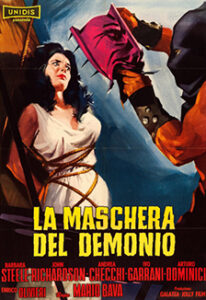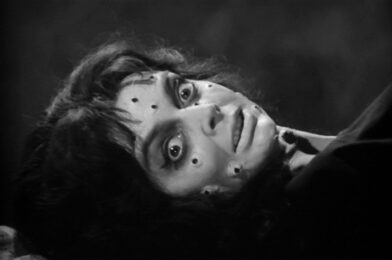Black Sunday (1960) – A Movie A Day 2021 #44
Black Sunday (1960) – A Movie A Day 2021 #44

Around this time last year I started reading and collecting The Dark Side magazine, a publication from the United Kingdom that seems to focus largely on older horror movies, though it does do reviews on more modern films as well. In the latest issue I purchased, there is an advertisement for a book published by The Dark Side that chronicles Italian horror cinema. As a huge fan of Italian horror and exploitation movies in general, it was a quick and easy purchase to make. Some of my favorite horror movies are from Italy, and I’m always eager to learn more about what I have and haven’t seen yet. The book, titled Italian Horrors: Cannibals, Zombies, Strange Vices and Guilty Pleasures, arrived just the other day, and it’s already inspired me to dive head-first into a bunch of Italian horror movies. So for today’s movie, I picked an Italian classic that I’m almost embarrassed to say I hadn’t seen before. Today I watched Mario Bava’s Black Sunday.
I’ve seen a handful of Bava’s later horror movies, but Black Sunday is the earliest of his films I’ve watched so far. According to IMDB it’s also the first non-documentary movie where he was actually given a directing credit, although Italian Horrors mentions that he helped finish other directors’ work prior to Black Sunday. Bava’s direction is confident and evocative. Bava gives Black Sunday a classically gothic feel while incorporating many beautifully gruesome images that would tend to become associated with Italian horror in the following decades.
Black Sunday stars Barbara Steele in a dual role as an evil witch, Asa, and the witch’s beautiful descendant, Katia. Two centuries ago, Asa was captured by villagers and sentenced to death for practicing witchcraft. The first step in the witch-killing process is to hammer a mask of Satan (a bronze mask filled with spikes) onto her face, but before that happens, Asa curses the man in charge of her demise. That man is Asa’s own brother, and the curse she places on him will be passed along to his descendants. The mask is then applied with a gush of blood. An attempt to burn Asa at the stake is then made, but it is thwarted by a sudden downpour. Regardless, Asa’s body is placed in a tomb with the mask of Satan to keep her powers in check and a cross placed on her stone coffin as added insurance.
Two hundred years later, a professor, Dr. Kruvajan, and his assistant, Dr. Gorobec, stumble upon Asa’s tomb. Their curiosity gets the better of them, and, one giant bat attack later, Asa’s stone coffin is busted and all of the safeguards keeping her dead are removed. A few drops of the professor’s blood after the bat attack begins the process of revival for Asa, and the bulk of the movie follows Asa’s attempts at regaining her full strength with the help of her undead lover Javutich. Asa feels a connection to Katia, and her ultimate goal is to drain Katia of her life force. What ensues is gothic horror complete with a creepy castle, mysterious deaths, and torch-bearing villagers.
I’m glad I finally watched Black Sunday, because it’s great. I love the mood, and Barbara Steele is magnetic in both of her roles. The story itself is good but maybe not too far away from a lot of other gothic horror movies, but the way its presented makes it memorable. There are many images that are now going to be vivid parts of my memory. One of the more iconic images is Asa’s hole-covered face after the mask of spikes is removed, but there are a good amount of creepy moments just as memorable. From Asa’s desiccated head with bugs crawling out of her eye sockets, to the spurt of blood when a not-so-dead dead guy is stabbed in the eye, to the flame-licked face of Asa as she stares through the fire meant to kill her, Black Sunday is a beautiful movie.

If you’re a fan of gothic horror, Black Sunday is a must-watch. I should have seen it years ago, but hey, at least I’ve seen it now. If nothing else, for historic purposes Black Sunday should be seen by pretty much any fan of horror. For one thing, Mario Bava had a tremendous influence not just on Italian horror, but on horror movies around the world. Also, in reading Italian Horror, Black Sunday was one of the early horror movies in Italy after the genre had been forbidden when Mussolini took power in the 1920s. There were horror movies in the very early 1920s, but it took until 1956’s I Vampiri for the genre to start its comeback in Italy. The Italians certainly made up for lost time by producing some of the most gruesome and transgressive horror films ever made, but even if you’re not into that, Black Sunday feels like it made up for lost time in a different way. It feels more akin to one of the Universal monster movies from the ’30s and ’40s, which, by the way, were regaining attention thanks to the Hammer horror movies being produced in Great Britain beginning in the mid-1950s. It was such an interesting time period for European horror.
As I sit here writing this, I want to dig back into Italian Horrors. The first main chapter covers some of the writers of the yellow-covered crime paperback books that inspired one of my favorite sub-genres, the giallo. So don’t be surprised if you see a deluge of black-gloved killers in some of my upcoming movies of the day. Oh yeah, and if you want to check out the book I’ve been referencing this whole time, you can order it here: https://thedarksidemagazine.com/product/italian-horrors-cannibals-zombies-strange-vices-and-guilty-pleasures/


